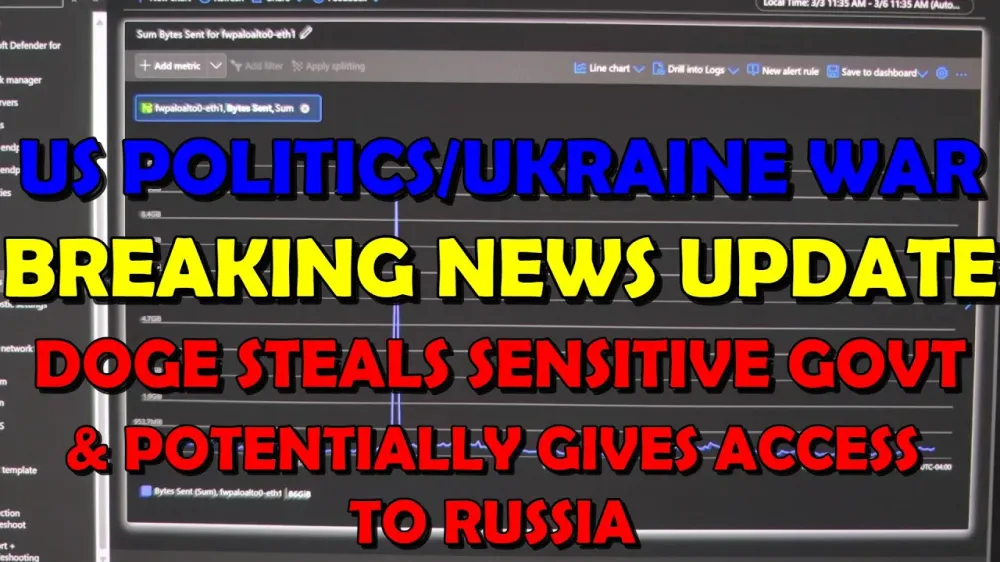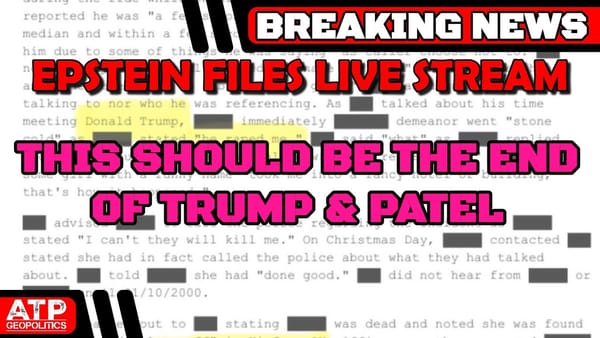BREAKING NEWS: DOGE Steal Sensitive Govt Data & Potentially Give Access to Russia
🤖
This summary has been produced automatically by an AI Large Language Model (LLM) without any human intervention. Whilst every effort has been made to prompt the LLM to produce accurate output, there may be inconsistencies, inaccuracies or hallucinations!
Table of Contents 📖
"Doge is either way responsible for Russia being able to gain access or potentially gain access to incredibly sensitive information On top of the fact that Doge has got access to that information is relaying that back to Elon Musk who is able to use sensitive union and corporate information to his own ends."
🤖💭 AI Plan (pre task) - the AI's step by step thought process
The step by step thought process is detailed above
Hello Team
🎦 00:00-00:15⏩
- Jonathan introduces a breaking news update regarding potential sensitive government data theft by "Doge" (Elon Musk's team) and possible links to Russia.
- He clarifies that while initially appearing to be US political news related to Elon Musk and "Doge" torching US institutions, it has potential Russian connections.
Whistleblower Disclosure: DOGE Accessing Sensitive NLRB Data
🎦 00:15-00:58⏩
- NPR has published a major article based on a whistleblower disclosure detailing how "Doge" may have accessed sensitive data from the National Labor Relations Board (NLRB).
- The NLRB is a small, independent federal agency handling unfair labour practices and stores confidential employee and proprietary business information.
- This data is valuable for union busting and gaining insights into businesses seeking government contracts, potentially benefiting individuals like Elon Musk.
Details of DOGE's Data Access and Suspicious Activity
🎦 00:58-02:25⏩
- "Doge" employees, reportedly led by a White House advisor and Elon Musk, aimed to access the NLRB's internal systems.
- Their stated mission was to review agency data for compliance and cost efficiency, but the data accessed is unlikely to serve this purpose.
- Technical staff became alarmed by a spike in data leaving the agency after "Doge" engineers were granted access.
Elon Musk's Potential Motives: Data for AI and Corporate Advantage
🎦 02:25-03:55⏩
- Jonathan references analysis by Kara Swisher and Scott Galloway suggesting Elon Musk's primary objective with "Doge" is data acquisition, not cost-cutting.
- Musk is competing with AI entities like OpenAI and needs data to gain an advantage for his AI project, Grok.
- Access to US government information would provide a significant competitive edge, enabling corporate espionage, government contract gains, and increased power.
Cover-up Attempts and Suspicious Russian IP Address Login
🎦 03:55-05:33⏩
- "Doge" team members requested their activities be unlogged and attempted to cover their tracks by disabling monitoring and deleting access records.
- Cybersecurity experts compare this evasive behaviour to that of criminal or state-sponsored hackers.
- Suspicious login attempts from a Russian IP address were detected, raising concerns about potential data exposure.
Whistleblower's Concerns and Lack of Transparency
🎦 05:33-07:35⏩
- The whistleblower believes the suspicious activity warrants investigation by agencies with greater resources.
- A screenshot shows a large, unusual spike in data leaving the NLRB databases.
- The White House statement claims "Doge" is transparent and aims to eliminate inefficiencies, which is contradicted by the NLRB staff's experience of cover-up attempts.
Whistleblower's Response to White House Claims and Broader Implications
🎦 07:35-08:53⏩
- The whistleblower refutes the White House's transparency claims, stating that access to "Doge's" code and activities is lacking.
- Sensitive corporate and union information within the NLRB data is of interest to both Elon Musk and foreign adversaries.
- The issue at the NLRB is likely not isolated, with similar incidents potentially occurring across other government agencies.
Critical Data Points: Russian Login Attempts and Starlink Data Exfiltration
🎦 08:53-10:47⏩
- Within 15 minutes of "Doge" creating user accounts, login attempts were made from Russia using the newly created usernames and passwords.
- "Doge" is allegedly using Starlink to exfiltrate data, potentially giving Russia direct access to information transmitted via Starlink.
- These two data points are presented as highly concerning and suggest potential Russian access through multiple routes.
Exposed Critical Infrastructure Databases and Chernobyl Analogy
🎦 10:47-11:31⏩
- Critical infrastructure databases across government agencies, including the Department of Energy and nuclear regulatory bodies, are reportedly exposed to the open internet.
- This situation is described as serious and likened to Chernobyl, with control panels lighting up after a meltdown, highlighting the severity of the security vulnerabilities.
- Jonathan commends the whistleblower for bringing this issue to public attention, emphasizing it's likely "the tip of the iceberg".
NPR Article's Importance and Deeply Worrying Nature
🎦 11:31-12:23⏩
- Jonathan stresses the significance of the NPR article and encourages viewers to read it for detailed information and evidence.
- He emphasizes the article's length and the deeply worrying nature of the revelations.
- Reiterates the near real-time login attempts from a Russian IP address shortly after "Doge" accessed NLRB systems.
Cybersecurity Expert Opinions and Potential Scenarios
🎦 12:23-13:59⏩
- Cybersecurity experts interviewed by NPR confirm the Russian login attempts were alarming, especially given the context of "Doge's" activities.
- Experts suggest that "Doge's" rapid and potentially reckless approach ("move fast and break stuff") creates vulnerabilities easily exploitable by malicious actors.
- Jonathan outlines two concerning possibilities: either "Doge" is complicit with Russia, or their incompetence allows Russia to easily exploit system weaknesses. A third possibility is also raised later: recruitment of "Doge" team members.
DOGE's Responsibility and Lack of Transparency
🎦 13:59-14:48⏩
- Jonathan asserts that "Doge" is responsible in either scenario for Russia potentially gaining access to sensitive information.
- He highlights the additional concern of "Doge" relaying sensitive data back to Elon Musk for his own benefit, including exploiting union and corporate information.
- He criticises the White House's claims of "Doge's" transparency as completely false, stating they are actively being untransparent.
Further Concerns: Foreign Adversary Recruitment and Systemic Issues
🎦 14:48-16:36⏩
- A third concerning scenario is introduced: foreign adversaries potentially recruiting or paying "Doge" team members for data access.
- Jonathan reiterates the principle of least privilege in cybersecurity, which "Doge" seems to be violating, increasing vulnerabilities.
- The whistleblower's lawyer emphasizes the sensitivity of the case, involving potential sophisticated foreign intelligence access to government systems, warranting Senate Intelligence Committee involvement.
Wider Implications: Pentagon Resignations and US Dismantling
🎦 16:36-18:24⏩
- Jonathan reveals that a large number of IT staff are resigning from the Pentagon, particularly from the Defence Digital Service, due to pressure from "Doge".
- He argues that the US is being "dismantled" by Elon Musk, Donald Trump, and the Trump administration.
- He claims their actions are handing power to Russia and China, either directly or to oligarchs and billionaires, through policies like trade wars and the influence of entities like "Doge".
Warning and Conclusion
🎦 18:24-18:40⏩
- Jonathan reiterates his warnings about the concerning trends and urges viewers to take note of these developments.
- He praises NPR's reporting as "marvelous" and highlights the Trump administration's attempts to defund such critical checks and balances, which he believes leads towards dictatorship.
Wrap up
🎦 18:40-18:52⏩
- Jonathan concludes by reiterating the importance of checks and balances like NPR and warns against their removal, associating it with the rise of dictatorships.
🤖❓ AI Debrief (post task) - anything the AI didn't understand
Everything understood
🤖💭 AI Plan (pre task) - the AI's step by step thought process
My thought process to generate the XML response followed these steps:
Deconstructing the Request: I first carefully read the entire prompt, paying close attention to the instructions for each task (1-6) and the rules/guidance provided for each. I noted the required XML tags, formatting conventions (British English, DD/MM/YYYY date format), and specific names/spellings to watch out for. I understood the context of "ATP Distilled" and Jonathan's channel, which helped inform the tone and focus of the summaries and quote selection.
Planning the XML Structure: Before starting any task, I mentally structured the XML output based on the "OVERALL XML STRUCTURE" example. This helped me visualise the final output and ensure I addressed all required elements in the correct order. I knew I'd need to populate `🤖💭 AI Plan (pre task) - the AI's step by step thought process `, ``, ``, ``, multiple ``, `
`, ``, `` blocks, a ` `, and `🤖❓ AI Debrief (post task) - anything the AI didn't understand
`.
- Task 1 (Title, Date, Part):
- I identified the video title: "BREAKING NEWS (20250416): DOGE Steal Sensitive Govt Data & Potentially Give Access to Russia".
- Extracted the Title by removing the date and part: "BREAKING NEWS: DOGE Steal Sensitive Govt Data & Potentially Give Access to Russia".
- Extracted the Date: "20250416" and converted it to DD/MM/YYYY format: "16/04/2025".
- Extracted the Part: There was no letter after the date, so the part is empty.
- I then wrapped these in the appropriate XML tags: `
`, `<date>`, and `<part>`.</li>
</ul>
<ol>
<li><b>Task 2 (Topic Titles):</b></li>
</ol>
<ul>
<li>I read through the transcript, paragraph by paragraph, identifying distinct topics. I aimed for granular topics as instructed.</li>
<li>I started with the mandatory "Hello Team" for the introduction (topic 1).</li>
<li>I identified key shifts in the discussion: introduction of whistleblower report, focus on data exfiltration, potential Russian involvement, wider implications, Pentagon resignations, and Jonathan's concluding thoughts.</li>
<li>For each topic, I formulated a concise and specific topic title, trying to quantify or add detail where possible (e.g., "Doge employees requested activities not be logged"). I prioritised descriptive titles over vague ones.</li>
<li>I ensured the first topic was "Hello Team" and the last was "Wrap up".</li>
<li>I numbered the topics sequentially and used these numbers for the `id` attribute in `<h2 class="topictitle" id=X>`.</li>
</ul>
<ol>
<li><b>Task 3 (Topic Timestamps):</b></li>
</ol>
<ul>
<li>I went back through the transcript and noted the start and end timestamps for each topic. I used the timestamps immediately before the start of a new topic and after the end of the current topic.</li>
<li>I carefully checked the timestamps against the transcript to ensure accuracy and correct format (MM:SS or HH:MM:SS).</li>
<li>I used `<topicts id=X>Timestamp start - timestamp end</topicts>` tags, ensuring the `id` matched the `<h2 class="topictitle" id=X>`.</li>
<li>I reviewed the timestamps to ensure they covered the entire video duration without significant gaps, confirming I hadn't missed any topics.</li>
</ul>
<ol>
<li><b>Task 4 (Topic Summaries):</b></li>
</ol>
<ul>
<li>For each topic, I re-read the corresponding section of the transcript and wrote a concise summary.</li>
<li>I used bullet points for clarity and readability as instructed.</li>
<li>I focused on extracting the key information, Jonathan's analysis, opinions, and any relevant details like sources (NPR, Kara Swisher, Scott Galloway).</li>
<li>I paid attention to British English and corrected any spelling errors or misheard words from the transcript (e.g., "Doge" was kept as is as it refers to the team/project name).</li>
<li>I tried to capture Jonathan's tone and passion where appropriate.</li>
<li>I wrapped each summary in `<div class="topicsummary" id=X></div><br><br><a class=link-top href="#top">Return to top</a>⤴️` tags, again matching the `id`.</li>
</ul>
<ol>
<li><b>Task 5 (Quote):</b></li>
</ol>
<ul>
<li>I reread the transcript looking for a quote that was impactful, concise, and representative of the video's main message.</li>
<li>I chose the quote: ""Doge is either way responsible for Russia being able to gain access or potentially gain access to incredibly sensitive information On top of the fact that Doge has got access to that information is relaying that back to Elon Musk who is able to use sensitive union and corporate information to his own ends."</li>
<li>I corrected any minor punctuation or spelling issues within the quote to ensure it was clear and grammatically correct.</li>
<li>I enclosed the quote in ` <blockquote></blockquote> ` tags.</li>
</ul>
<ol>
<li><b>Task 6 (Queries):</b></li>
</ol>
<ul>
<li>I reviewed all tasks and the transcript to see if anything was unclear or caused confusion.</li>
<li>I determined that everything was understandable and that I was able to follow all instructions.</li>
<li>I explicitly stated "Everything understood" within the `<div class="kg-card kg-toggle-card" data-kg-toggle-state=close><div class=kg-toggle-heading><h4 class=kg-toggle-heading-text>🤖❓ AI Debrief (post task) - anything the AI didn't understand</h4><button class=kg-toggle-card-icon><svg id=Regular xmlns="http://www.w3.org/2000/svg" viewBox="0 0 24 24"><path class=cls-1 d="M23.25,7.311,12.53,18.03a.749.749,0,0,1-1.06,0L.75,7.311"/></svg></button></div><div class=kg-toggle-content><p><span style="white-space: pre-wrap;"> </span></p></div></div> ` tags as requested when there are no queries.</li>
</ul>
<ol>
<li><b>Final Review and XML Output:</b></li>
</ol>
<ul>
<li>I performed a final check of the entire XML output. I verified:</li>
<li>All XML tags were correctly opened and closed and that closing tags matched the opening tags (crucial to avoid errors).</li>
<li>All `id` attributes in `<h2 class="topictitle">`, `<topicts>`, and `<div class="topicsummary">` were correctly matched and sequential.</li>
<li>The date format was DD/MM/YYYY.</li>
<li>British English was used throughout.</li>
<li>Ukrainian spellings (though not applicable in this transcript) and specified names were considered.</li>
<li>No extraneous information was added to the summaries.</li>
<li>I then outputted the complete XML response as requested in the prompt.</li>
</ul>
By following these systematic steps, I aimed to address each task methodically, ensuring accuracy, adherence to instructions, and a well-structured and correct XML output. The initial planning and step-by-step approach were key to managing the multiple requirements of the prompt. </span></p></div></div></body></div>
</div>
` blocks, a `
`, and `🤖❓ AI Debrief (post task) - anything the AI didn't understand
`.
- Task 1 (Title, Date, Part):
- I identified the video title: "BREAKING NEWS (20250416): DOGE Steal Sensitive Govt Data & Potentially Give Access to Russia".
- Extracted the Title by removing the date and part: "BREAKING NEWS: DOGE Steal Sensitive Govt Data & Potentially Give Access to Russia".
- Extracted the Date: "20250416" and converted it to DD/MM/YYYY format: "16/04/2025".
- Extracted the Part: There was no letter after the date, so the part is empty.
- I then wrapped these in the appropriate XML tags: `
`, `<date>`, and `<part>`.</li> </ul> <ol> <li><b>Task 2 (Topic Titles):</b></li> </ol> <ul> <li>I read through the transcript, paragraph by paragraph, identifying distinct topics. I aimed for granular topics as instructed.</li> <li>I started with the mandatory "Hello Team" for the introduction (topic 1).</li> <li>I identified key shifts in the discussion: introduction of whistleblower report, focus on data exfiltration, potential Russian involvement, wider implications, Pentagon resignations, and Jonathan's concluding thoughts.</li> <li>For each topic, I formulated a concise and specific topic title, trying to quantify or add detail where possible (e.g., "Doge employees requested activities not be logged"). I prioritised descriptive titles over vague ones.</li> <li>I ensured the first topic was "Hello Team" and the last was "Wrap up".</li> <li>I numbered the topics sequentially and used these numbers for the `id` attribute in `<h2 class="topictitle" id=X>`.</li> </ul> <ol> <li><b>Task 3 (Topic Timestamps):</b></li> </ol> <ul> <li>I went back through the transcript and noted the start and end timestamps for each topic. I used the timestamps immediately before the start of a new topic and after the end of the current topic.</li> <li>I carefully checked the timestamps against the transcript to ensure accuracy and correct format (MM:SS or HH:MM:SS).</li> <li>I used `<topicts id=X>Timestamp start - timestamp end</topicts>` tags, ensuring the `id` matched the `<h2 class="topictitle" id=X>`.</li> <li>I reviewed the timestamps to ensure they covered the entire video duration without significant gaps, confirming I hadn't missed any topics.</li> </ul> <ol> <li><b>Task 4 (Topic Summaries):</b></li> </ol> <ul> <li>For each topic, I re-read the corresponding section of the transcript and wrote a concise summary.</li> <li>I used bullet points for clarity and readability as instructed.</li> <li>I focused on extracting the key information, Jonathan's analysis, opinions, and any relevant details like sources (NPR, Kara Swisher, Scott Galloway).</li> <li>I paid attention to British English and corrected any spelling errors or misheard words from the transcript (e.g., "Doge" was kept as is as it refers to the team/project name).</li> <li>I tried to capture Jonathan's tone and passion where appropriate.</li> <li>I wrapped each summary in `<div class="topicsummary" id=X></div><br><br><a class=link-top href="#top">Return to top</a>⤴️` tags, again matching the `id`.</li> </ul> <ol> <li><b>Task 5 (Quote):</b></li> </ol> <ul> <li>I reread the transcript looking for a quote that was impactful, concise, and representative of the video's main message.</li> <li>I chose the quote: ""Doge is either way responsible for Russia being able to gain access or potentially gain access to incredibly sensitive information On top of the fact that Doge has got access to that information is relaying that back to Elon Musk who is able to use sensitive union and corporate information to his own ends."</li> <li>I corrected any minor punctuation or spelling issues within the quote to ensure it was clear and grammatically correct.</li> <li>I enclosed the quote in ` <blockquote></blockquote> ` tags.</li> </ul> <ol> <li><b>Task 6 (Queries):</b></li> </ol> <ul> <li>I reviewed all tasks and the transcript to see if anything was unclear or caused confusion.</li> <li>I determined that everything was understandable and that I was able to follow all instructions.</li> <li>I explicitly stated "Everything understood" within the `<div class="kg-card kg-toggle-card" data-kg-toggle-state=close><div class=kg-toggle-heading><h4 class=kg-toggle-heading-text>🤖❓ AI Debrief (post task) - anything the AI didn't understand</h4><button class=kg-toggle-card-icon><svg id=Regular xmlns="http://www.w3.org/2000/svg" viewBox="0 0 24 24"><path class=cls-1 d="M23.25,7.311,12.53,18.03a.749.749,0,0,1-1.06,0L.75,7.311"/></svg></button></div><div class=kg-toggle-content><p><span style="white-space: pre-wrap;"> </span></p></div></div> ` tags as requested when there are no queries.</li> </ul> <ol> <li><b>Final Review and XML Output:</b></li> </ol> <ul> <li>I performed a final check of the entire XML output. I verified:</li> <li>All XML tags were correctly opened and closed and that closing tags matched the opening tags (crucial to avoid errors).</li> <li>All `id` attributes in `<h2 class="topictitle">`, `<topicts>`, and `<div class="topicsummary">` were correctly matched and sequential.</li> <li>The date format was DD/MM/YYYY.</li> <li>British English was used throughout.</li> <li>Ukrainian spellings (though not applicable in this transcript) and specified names were considered.</li> <li>No extraneous information was added to the summaries.</li> <li>I then outputted the complete XML response as requested in the prompt.</li> </ul> By following these systematic steps, I aimed to address each task methodically, ensuring accuracy, adherence to instructions, and a well-structured and correct XML output. The initial planning and step-by-step approach were key to managing the multiple requirements of the prompt. </span></p></div></div></body></div> </div>



